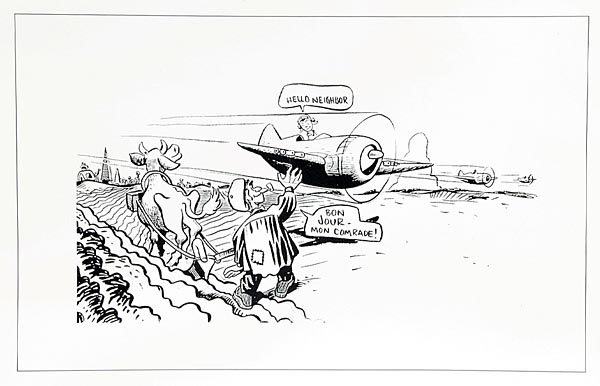Skip to comments.
67 years after D-Day, the French honor a pilot from Newport News
Daily Press ^
| June 5, 2011
| Hugh Lessig,
Posted on 06/06/2011 5:57:39 AM PDT by csvset
HAMPTON — 1st Lt. William S. Marchant of Newport News was killed on June 10, 1944, when his fighter plane was shot down over a small town in France. It was the fourth day of the operation that began with the D-Day landing at Normandy. Marchant was 23 years old.
The Germans came upon the wreckage, but they didn't take Marchant away. Their message to the French villagers: Do whatever you want with the body. A carpenter in the village built a coffin. Others carefully prepared the body for burial. In a village wracked by war and still under the threat of German oppression, 500 people turned out for the funeral.
Today, Marchant is buried at an American cemetery near Rennes, France, a long way from his home in the 600 block of 29th Street in Newport News, where he played the daredevil as a kid, jumping off the roof with a bed sheet as a parachute.
He never made it home, but now his surviving family members have decided to come to him. And it promises to be a bittersweet trip. Through a series of events, the mayor and council members of Mouaze, near where Marchant crashed, have decided to honor the American pilot who died in their midst, helping to liberate their country.
They will hold a special service on June 10, the anniversary of his death, and unveil a memorial plaque beside the village war memorial. They will also have preserved pieces of the aircraft. Marchant's two surviving sisters, Frances M. Hall and Golden Marchant Forbes, will travel to France for the service. "It's going to be a hard trip, a hard trip," said Forbes.
(Excerpt) Read more at dailypress.com ...
TOPICS: History; Local News; Military/Veterans
KEYWORDS: france; p47; virginia; wwii
Pic and video at the link.
1
posted on
06/06/2011 5:57:44 AM PDT
by
csvset
To: csvset
At least the French still have some decency left.
2
posted on
06/06/2011 6:10:38 AM PDT
by
rightly_dividing
(1 Cor. 15:1-4 Believe it!)
To: rightly_dividing
Very classy of them, kudos.
3
posted on
06/06/2011 6:41:12 AM PDT
by
Amberdawn
To: rightly_dividing
I was stationed in Spain from 68-72. At that time, anti-Americanism ( because of Vietnam) was rampant all through Europe. I travelled the continent extensively during those years, including 2 trips to Normandy, and visits to the cemetery. Even then, the French people in the small villages along the coastline were very pro-American. They visited the gravesites often, many knew particular soldiers who had died. They were eager to take me around, for they all lived throught D-Day and the months after, show me the particular sites, where this happened, and that soldier had died. It was a remarkable experience..
4
posted on
06/06/2011 7:35:33 AM PDT
by
ken5050
(Save the Earth..It's the only planet with chocolate!!!)
To: csvset
That picture at the source showing Marchant and his P-47 reminded me of this:

The artist, George Rarey, was also a P-47 pilot who ended up in a French grave. George's son put much of his dad's wartime artwork on a website as a tribute (www.rareybird.com), but it shut down after the son passed away a few years ago.
It's well worth digging through internet archives to see most of the site's former contents.
5
posted on
06/06/2011 8:54:25 AM PDT
by
Charles Martel
(Endeavor to persevere...)
To: Charles Martel
6
posted on
06/06/2011 10:35:30 AM PDT
by
Liberty Valance
(Keep a simple manner for a happy life :o)
Disclaimer:
Opinions posted on Free Republic are those of the individual
posters and do not necessarily represent the opinion of Free Republic or its
management. All materials posted herein are protected by copyright law and the
exemption for fair use of copyrighted works.
FreeRepublic.com is powered by software copyright 2000-2008 John Robinson
